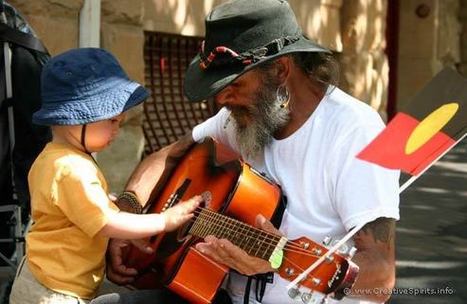Via Catherine Smyth
Get Started for FREE
Sign up with Facebook Sign up with X
I don't have a Facebook or a X account
 Your new post is loading... Your new post is loading...
 Your new post is loading... Your new post is loading...
|

Thanh Thuong Nguyen's curator insight,
April 12, 2014 11:26 PM
Through the meaning implied in Aboriginal celebration of Survival Day, the page introduces Aboriginal perspective about the contemporary issue existing in Australia. When Australian people are celebrating Australian Day, many Aboriginal people found there is little to celebrate with the same meaning; rather, they celebrate Survival Day that implies their commemoration of a deep loss_ the loss of their rights to their land, loss of family, loss of the right to practice their culture. The source also includes Aboriginal participation by representing difference voices of Aboriginal people about the issue. The site also emphasises the account of Aboriginal and non-Aboriginal history by introducing the emerging thinking in some Australians about the concept of “Arrival Day” celebration in which both Indigenous and Australian history are praised and promoted. The source provides teachers with a different perspective from which they can design teaching activities that promote students developing different viewpoints. This is a useful resource for teachers not only in term of obtaining information to teach the concept and the origin of Australia Day, but also in term of teaching the story implied in the event viewed from an Aboriginal point of view. By applying the idea of this resource into teaching, teachers would be able to raise students’ awareness of the diversity that has been existed since the foundation of the country in which they are living, and advise them the existing discrimination that they should avoid. When carry on any teaching activities that requires students to collect data about the event from different perspective, it is crucial for teachers to provide enough guidance to students in order to avoid encountering sensitivity and offensiveness.
Bianca Levins's curator insight,
March 29, 2015 7:40 AM
Through poetry, song and stories, this page offers Aboriginal perspectives on Australia day. After several lessons spent discussing what Australia Day means to different people, this resource asks students to think deeper about the day and its significance for Aboriginal people.
Many Aboriginal people call January 26 Invasion Day or Survival Day. Why is that? To clarify their thoughts, students could complete a fishbone diagram (Global Education, 2014). Global Education suggest labeling the scales with “how, why, when, where and what” (2014). For example, ‘HOW does this person feel? WHY do they feel this way? WHAT does this make me feel?’
Students could expand their individual ideas in an independent assessment task, looking at the Creative Spirits site. Students could choose to present their findings in a variety of ways, for example as a poem about how a particular story made them feel to be read at assembly (inspired by a project at Coffs Harbour Public School), a report for the class blog, or an educational poster to display in the school to raise awareness.
REFERENCES: Global Education. (2014). Retrieved 31 March, 2015 from http://globaleducation.edu.au/verve/_resources/fishbone.pdf
Coffs Harbour Public School (2015). Retrieved 31 March, 2015 from http://coffsharbourpublicschool.edublogs.org/2014/03/20/august-6th-1945-nagasaki-and-hiroshima-bombings-by-6h/#more-5160

Claire Reinthal's curator insight,
April 20, 2015 6:00 AM
Description of what is on this site:
This resource explains the HSIE outcome at CCS2.2 in relation to what has become known as Australia Day but is mourned as Invasion Day by many Aboriginal people.
This is done by looking at Australia Day over time and from the perspective of different Aboriginal people and the impacts the arrival of the British had on their family members/ancestors and on them personally.
This is a good follow-on resource from First Australians, Episode 1, since it gives the perspectives of people of today on the events which happened in 1788 and their impacts now.
A teaching idea and link to relevant pedagogical research:
Working in groups, students could be asked to look at the changes in the community and family life and impacts of these due to the arrival of the British, January 26, 1788 and to create a timeline of events which caused these changes or resulted from them, including quotes from different Aboriginal people.
The students could be told that this task would be assessed and students asked to help devise a rubric for assessing this outcome since "...learning is best achieved when students are actively involved in the teaching and learning process." (Bobis, Mulligan, & Lowrie, 2013, p. 291). This lessons learning would be assessed formatively.
A literacy strategy/link to English KLA:
Again, this task would also be fulfilling outcomes in the NSW English Syllabus for the Australian Curriculum such as: EN2-6B 'distinguishes between different forms of English' and 'identifies organisational patterns and features' and 'listen to and contribute to conversations and discussions to share information and ideas'.
References:
Bobis, J.,Mulligan, J., & Lowrie, T. (2013). Mathematics for Children: Challenging children to think mathematically. Frenchs Forest: Pearson Australia.
Creative Spirits, Jens Korff (2014). Australia Day – Invasion Day. Retrieved April 20, 2015, from http://www.creativespirits.info/aboriginalculture/history/australia-day-invasion-day#toc0 |












Planning historical inquiry in the primary classroom
To help young children develop an understanding of the past, teachers can design a historical inquiry around topics that are relevant to their students (e.g. school, family, toys)
Teaching ideas:
For further reading:
Cooper, H.(2002). History in the early years.
Husbands, C. (1996). What is history teaching?